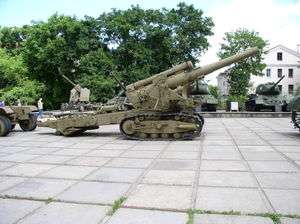203 mm howitzer M1931 (B-4)
| 203 mm howitzer M1931 (B-4) | |
|---|---|
|
203 mm howitzer M1931 (B-4) in Great Patriotic War museum, Minsk, Belarus. | |
| Type | Heavy howitzer |
| Place of origin | USSR |
| Production history | |
| Designer | Nikolai Nikititsch Magdesiew |
| Designed | 1931 |
| Produced | 1932-1940s |
| No. built | 871 |
| Specifications | |
| Weight |
Combat: 17,700 kg (39,022 lbs) Travel: 19,000 kg (41,888 lbs) |
| Barrel length |
Bore: 4.894 m (16 ft 1 in) L/24.1 Overall: 5.087 m (16 ft 8 in) L/25 |
|
| |
| Shell | HE: 100 kg (220 lbs) |
| Caliber | 203 mm (8 in) |
| Breech | interrupted screw |
| Elevation | 0° to 60° |
| Traverse | 8° |
| Rate of fire | 1 round per minute |
| Muzzle velocity | 607 m/s (1,990 ft/s) |
| Maximum firing range | 18 km (11 mi) |
| Wikimedia Commons has media related to 203 mm howitzer M1931 (B-4). |
203 mm howitzer M1931 (B-4) (Russian: 203-мм гаубица обр. 1931 г. (Б-4)) was a 203 mm (8 inch) Soviet heavy howitzer. During the Second World War, it was under the command of the Stavka's strategic reserve. It was nicknamed "Stalin's sledgehammer" by German soldiers. These guns were used with success against heavy German fortifications and in urban combat for crushing protected buildings and bunkers. This weapon was used until the end of the war in the Battle of Berlin where the Red Army would bring these guns up at point blank range to smash German fortifications with their heavy 203mm shells. In the spring of 1944, a KV-1s tank chassis was used to create a self-propelled variant, the S-51. The heavy recoil from the muzzle blast threw the crew off their seats and damaged the transmission, and so it was cancelled.[1]
Operators
-
 Soviet Union
Soviet Union  Ukraine-Was brought back in service in 2015.[2]
Ukraine-Was brought back in service in 2015.[2]
See also
- 152 mm gun M1935 (Br-2) shared same carriage
- 280 mm mortar M1939 (Br-5) shared same carriage
- 8 inch Howitzer M1 approximate United States equivalent
- BL 7.2-inch howitzer approximate British equivalent
References
- ↑ http://albumwar2.com/battle-of-berlin-b-4-203mm-howitzer/
- ↑ На озброєння 28 омехбр надійшла батарея 203-мм гармат Б-4 зразка 1931 року — Військова панорама, 30 листопада 2015
- Shunkov V. N. - The Weapons of the Red Army, Mn. Harvest, 1999 (Шунков В. Н. - Оружие Красной Армии. — Мн.: Харвест, 1999.) ISBN 985-433-469-4

